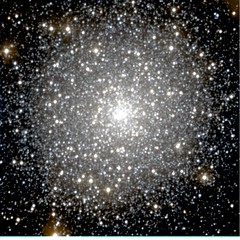
M92 - Globular Cluster
Originally uploaded by Astro Guy.
One always seems to apply that space is quiet. Well, that's true in the sense that sounds needs a medium to travel through (eg. air!). However, sound is also our brains interpretation of the frequencies that we hear. Image that you could interept the light traveling to you from stars as sounds, what would you hear? Normally nothing. A star such as the Sun vibrates with a period of 5 minutes. If you interpret this as a sound, that puts it at a frequency of 0.003 Hz. The average person hears sounds from about 20 to 20000 Hz. We can hear vibrations at a much higher rate.
What makes a star sound interesting, is that there is usually more than one note. This is evident in the fourier transforms of light curve data that I've shown in previous posts where many individual frequencies are present. A star is more like a chord. So lets ramp up the frequencies and listen!
I've done this with some data from the MOST satellite that I've been working with. You can find some of the mp3s here for your listening pleasure. Some of the stars sound like ring sheets of metal, others sound like diseased cat making love (not so nice). You be the judge. If you do download any of the sound files for use be sure to reference the MOST satellite.
In each case I've matched the largest amplitude frequency to 500 Hz and allows the other frequencies to fall as they will.
3 comments:
Hey Jason,
That is such a cool thought. Thanks for making me grin, I can't wait to get home and listen to star chords.
Take Care
Jennith
p.s. blogjacked again while my brother was doing something or other. new url = www.jennithpeart.blogspot.com which I plan on keeping even if I have to kick my brothers butt.
Wow! That is just freaky.
I had a lot of fun making those files. Now the first thing I want to do when I get a new data set is make a sound file.
Post a Comment